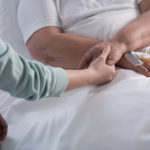In November 2014, the New Jersey Assembly voted to pass a new statute entitled “Aid in Dying for the Terminally Ill Act.” In December, the Senate version of the assisted suicide act was released from committee for a floor vote.
The debate over the merits of legalizing assisted suicide law has just begun in New Jersey, as it has across the nation. Three states have now adopted assisted suicide statutes, and the push is on for many more. On December 15, I entered that debate by testifying before the Senate Health Committee. One of my cousins, Richard Fritzky, submitted written testimony that day. Although our stories are personal, I believe that they communicate values of lasting national significance.
Rich and I come from a very large family. My paternal grandparents had eight children, twenty-four grandchildren, sixty-five great grandchildren, and over a hundred great-great grandchildren. Then there were my grandmother’s siblings and their families, my grandfather’s siblings and families, and my mother’s family. There were hundreds in our family—not even counting in-laws!
Over the years, we lost grandparents, parents, aunts and uncles, cousins, brothers and sisters, nieces and nephews. Some of us lost children and even grandchildren. We have experienced virtually every kind of end-of-life scenario. While there is always a measure of sadness—especially when suffering and death come unexpectedly—the deaths of our family members were always marked with a celebration of life. Therein lies the paradox. With each death, we feel diminished. Yet, with the realization of the fullness of our loved one’s life, we feel more fulfilled.
Start your day with Public Discourse
Sign up and get our daily essays sent straight to your inbox.Rich’s Story
My cousin Rich is a bright intellectual. For many years, he was the president of the Meadowlands Chamber of Commerce. He poured his life into service, founding two charities and serving on the boards of six others. He served on numerous state commissions, working to improve New Jersey’s literacy, employment, and natural resources. Rich was also the founder of Meadowlink, the finest transportation management association in the United States. Always a gifted writer, Rich was a professor at Fairleigh Dickinson University, where he helped develop a program to allow the New York Giants’ football players to complete a college education. He forged long-time friendships with some of those players, including George Martin, the captain of one of the Giants’ Superbowl teams.
Nine years ago, in October 2005, at the age of fifty-five, Rich Fritzky was suddenly and brutally stricken with Neisseria Meningitis, a particularly deadly disease. He slipped into a coma, and his wife and twelve children were told that he would die within a matter of days. In fact, the physicians who cared for him said it was impossible for him to survive. Yet he remained in a coma for four months. During that time, every one of his major organs, at one time or another, failed to function. His heart stopped. His kidneys failed, and he flat-lined.
His wife was told that, if by some miracle he were to survive, Rich would never recognize her or their children again, nor would he be able to have a cognitive thought. The physicians thought Rich’s family should pray for his death, not for his life.
They prayed for his life.
While in the coma, Rich’s heart had to endure six weeks of fever that reached 107 degrees—six weeks during which he had to be packed in ice. For six months, the physicians continually repeated that Rich’s death was imminent. On one occasion, when I visited the comatose Rich, his face had necrosed. It was entirely black. For six months, Rich Fritzky did not move, did not breath, did not swallow, and did not speak.
But Rich came out of his coma. He awoke to find that both of his legs had been amputated, as well as all ten of his fingers. His hospitalization lasted fifteen months and included a vigorous and painful rehabilitation, a failed effort to fit prosthesis, continual bouts with infections, and difficult-to-manage bed sores. Although the illness left his body broken and scarred, his mind and wits were as keen as ever, and he loved his family more than ever before.
When he returned home, the man with no fingers had to teach himself to type. His pain was often excruciating, and he had many subsequent hospitalizations and operations. Three years ago, he was forced to endure dialysis three days a week. Last summer, after a number of false starts because of infections and weakness, he successfully underwent a kidney transplant, donated by one of his sons.
Rich went back to his teaching job at Fairleigh Dickinson. Over the past four years, he has written three books and helped two other authors to write theirs. His children finished their education, and one of his sons is currently finishing medical school. In recent years, on at least three separate occasions, he was told that his death was a certainty—that it would occur in a matter of days or a week. Every day for the past nine years, he has experienced extreme pain.
Yet a month ago Rich Fritzky told me that his life has never been more exciting, more fulfilling, or more purposeful.
Theology of Suffering
One of the books that Rich recently wrote, which will be published this month, was a book about our Aunt Mary Cassidy Varick, a sister of his mother and my father. When our Aunt Mary was in her mid-thirties, she was diagnosed with leukemia. She had four young children, and in 1951 the medical profession was not able to effectively treat the illness. The cancer progressed until she was totally bedridden and in extreme pain. She reached the point where the doctors told her she had only a few days to live.
Mary had one wish. She wanted her husband to take her to the Shrine of St. Anne in Beaupré, Quebec. In those days, it was an excruciatingly long car ride, and the doctor predicted she would not survive the trip.
Mary’s husband Bill and one of her brothers, Ed, put her in the back of a 1940-something Chevy and set out for Canada. They had to stop on the way periodically to stretch her out on the side of the roadways to relieve some of her pain. They arrived at St. Anne’s in time for a special feast day Mass. Something miraculous happened that night, and when Mary returned to New Jersey there wasn’t a trace of cancer.
Shortly after her return, she founded a charitable organization, and for the next thirty-eight years she devoted herself to work with the disabled. Mary herself wrote several books, and her story has touched countless lives. Rich titled his book about her A Pilgrim’s Song: Mary Varick’s Theology of Suffering.
It’s a Wonderful Life
Had the assisted suicide bill now pending in the New Jersey Legislature been the law during the illnesses of Mary and Rich, it is likely that our state would have killed two of God’s greatest creations.
No one wants pain. But the debate about assisted suicide is not just about those who are terminally ill and in pain. It is about all of us. It is about whether we will help kill them by adopting laws that authorize and promote killing as a good. We must remember that some of the world’s greatest evils have been promoted in the name of human compassion.
In his testimony before the New Jersey Senate Committee, Rich Fritzky reminded us of a scene in the 1947 classic directed by Frank Capra, It’s a Wonderful Life. In that scene, after George Bailey pulls a man named Clarence (actually George’s guardian angel) out of a raging river under a bridge, the two are drying off in front of a stove in the office of the bridge attendant. When George Bailey says he saved Clarence, Clarence corrects him. Clarence explains that he jumped into the river in order to save George, because George was about to commit suicide. The bridge attendant chimes in, “Oh, it’s against the law to commit suicide around here.” Clarence responds, “It’s against the law where I come from, too!”
This proposed bill doesn’t just make suicide legal, lifting criminal prohibition. It does far more. It implicates all of us in the act of killing. It isn’t just the four or five persons it takes to help the sick person take his life. The proposal is for all of us, all eight million residents of New Jersey. By passing a law that enables the taking of human life, we are all implicated in the act. In effect, all eight million of us would be signing onto the consent that authorizes the killing of a human being.
Teach Your Children Well
In his famous Harvard Law Review article, “The Path of the Law,” the revered United States Supreme Court Justice Oliver Wendell Holmes wrote: “The law is a witness and external deposit of our moral life. Its history is the history of the moral development of the race.” Our laws teach the young what is considered criminal and what is acceptable. They teach standards of right and wrong according to the conduct they deter and the conduct they encourage.
So what exactly will we teach? What will we promote?
As government continues to take over the management of medical care, controlling its distribution, quality, and cost, there will be even greater pressure to discourage proper treatment for the terminally ill. We would be naive to believe that the ill will not be exploited to save money. We would be naive to believe that the idea of a particular patient considering suicide will originate with the person suffering the pain. In the state of New Jersey, where wrongful life lawsuits are legal, physicians will justifiably fear that they could be sued for malpractice if they do not clearly advise patients that they could avoid pain by committing suicide.
Rich Fritzky suggests that we must look beyond the here and now. He wrote, in part, to the legislature:
I revere life. I revere this remarkable gift that each and every one of us has been given and while I have great sympathy for those whose quality of life or suffering or prognosis or mental state might lead them to reach for an end; and even for those who compassionately argue for their right to do so, I submit that it is the right of neither. It is the right and the promise of a gentle power far mightier than you or we or this or any other state.
What do we want to teach our children and grandchildren? Do we want to teach that life has intrinsic value that we must respect? Or do we want to teach them that we can help some people take their own lives—that some people don’t matter?
Since Rich survived his meningitis, George Martin, several of his fellow New York Giants, and Fairleigh Dickinson University hold an annual banquet in Rich’s honor every November. It is attended by six to eight hundred friends and relatives, many of whom attend in thanksgiving for the good works he performed for them. At the latest banquet, Rich’s new book—co-authored with George Martin—was available, with George autographing copies.
When two of my ten-year-old grandchildren asked Rich to autograph their copy, Rich painstakingly signed his name. Then the man with no fingers took the pen between his hands and wrote a personal note to them: “Cade and Claudia: Thank you for caring about me.”
That is the lesson I want for our grandchildren. Not the lessons taught by Assembly Bill 2270.














